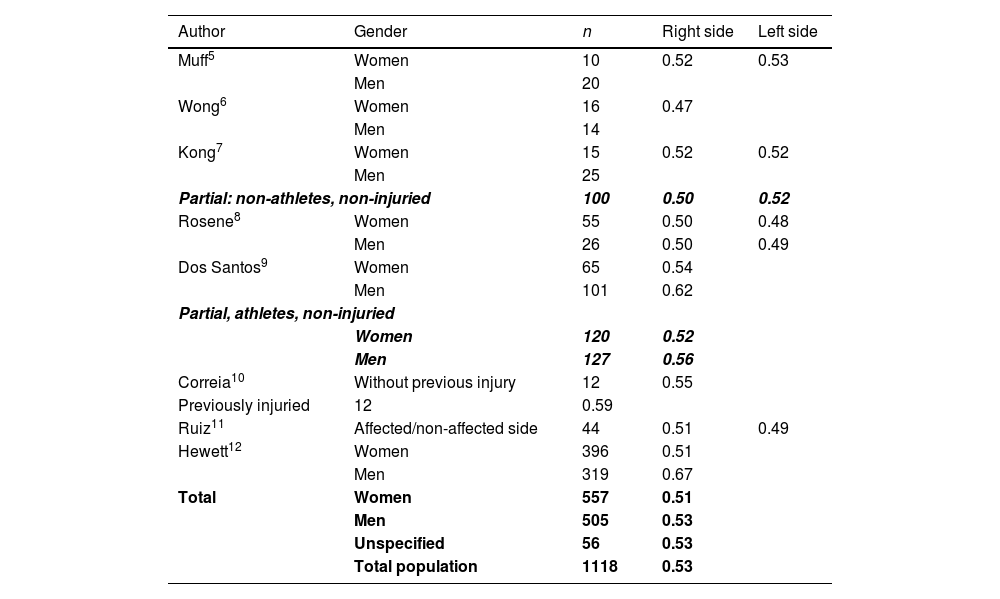In knee isokinetic tests, the ratios have had a specific value, in addition to the torque peak;1 and for years, the concentric hamstrings/quadriceps ratio [Hcon/Qcon] has been accepted as an indicator of kinetic stability in topics such as injury prevention and functional recovery,2 with a value of 0.6 as normal,3 in tests performed at 60°/s. Steindler, who first described this, established a 3:2 ratio as the cutoff.4 However, we have observed that, in our own data, and in different published works, a value lower than this is frequently reported, both in people with knee pathology and in athletes. Already previously, it had been questioned in isometric values as well.4
In apparently healthy people, not athletes, Muff5 reports a ratio of 0.52 and 0.53, on the dominant and non-dominant sides, respectively; while Wong6 reports 0.47, in a comparable group, without differentiating sex or side. Kong and Burns7 studied the ratios in men and women, without finding significant differences between them, in terms of these balances; the reported value was 0.52.
In athletes, Rosene8 summarizes different collegiate sports [soccer, volleyball, basketball and softball], separated according to whether they are male or female, and on average, it is found that this ratio is 0.5 on average, in both genders; with similar values in sports studied; although Dos Santos,9 finds an average of 0.54 for female athletes and 0.62 for male athletes. Correia10 found in professional soccer players with hamstring muscle injury, a value of 0.55 on the side without previous injury, and 0.59 on the side previously injuried.
Ruiz,11 in a population with knee arthroplasty, after completing an rehabilitation process, found a ratio of 0.51 on the affected side, and 0.49 on the unaffected side.
Finally, in a systematic review, Hewett12 summarizes some papers about people without injury, 396 women and 319 men, finding a ratio of 0.51 for women and 0.67 for men.
When we carry out a simple analysis of these authors, we find that the average obtained for women is 0.51 and 0.53 for men; for subjects without specifying sex, 0.53; and for the total population from these studies, 0.53. The results are described in Table 1.
Summary of Hcon/Qcon ratios studied.
| Author | Gender | n | Right side | Left side |
|---|---|---|---|---|
| Muff5 | Women | 10 | 0.52 | 0.53 |
| Men | 20 | |||
| Wong6 | Women | 16 | 0.47 | |
| Men | 14 | |||
| Kong7 | Women | 15 | 0.52 | 0.52 |
| Men | 25 | |||
| Partial: non-athletes, non-injuried | 100 | 0.50 | 0.52 | |
| Rosene8 | Women | 55 | 0.50 | 0.48 |
| Men | 26 | 0.50 | 0.49 | |
| Dos Santos9 | Women | 65 | 0.54 | |
| Men | 101 | 0.62 | ||
| Partial, athletes, non-injuried | ||||
| Women | 120 | 0.52 | ||
| Men | 127 | 0.56 | ||
| Correia10 | Without previous injury | 12 | 0.55 | |
| Previously injuried | 12 | 0.59 | ||
| Ruiz11 | Affected/non-affected side | 44 | 0.51 | 0.49 |
| Hewett12 | Women | 396 | 0.51 | |
| Men | 319 | 0.67 | ||
| Total | Women | 557 | 0.51 | |
| Men | 505 | 0.53 | ||
| Unspecified | 56 | 0.53 | ||
| Total population | 1118 | 0.53 | ||
We know the importance of biomechanical balance for knee stability, but we also know the importance of returning to activity in people who are recovering from an injury, which is why we must reconsider whether the value of 0.6 is really the expected, or if we must accept that, it is at 0.5 ± 0.05, giving the weight of a new value, to the Hcon/Qcon, in non-athletes, or in athletes in return-to-activity phase, where a neuromuscular control is the aim13; beyond the importance of the functional ratio Hexc/Qcon, the functional tests to determine dynamic knee valgus,14 or the assessment of this ratio in a specific torque angle, or the rate of torque development.4







